PREVIOUS
The Election commission of India and Elections History - Part 6
May 12 , 2024
349 days
3256
0
(இதன் தமிழ் வடிவத்திற்கு இங்கே சொடுக்கவும்)
System of Elections to Lok Sabha
Territorial Constituencies:
- Each state divided into territorial constituencies for direct Lok Sabha elections.
- Constitution (Article 82) ensures uniformity in seat allocation based on population ratios.
- Uniform representation maintained between states and within constituencies.

Readjustment after Each Census:
- Allocation of seats and constituency division are revised after every census.
- Parliament empowered to determine the process, enacted Delimitation Commission Acts.
- Acts were passed in 1952, 1962, 1972, and 2002 for readjustment purposes.
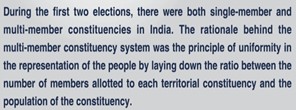
Reservation of Seats for SCs and STs:
- Constitution (Article 330) provides for reservation of seats for SCs and STs in Lok Sabha based on population ratios.
- Originally, this reservation was to operate for ten years, continuously extended by 10 years.
- Members of SCs and STs eligible to contest general seats as well.
- 84th Amendment Act (2001) and 87th Amendment Act (2003) revised reserved seat allocation based on census data.
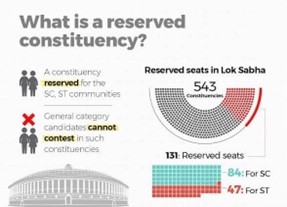
First-Past-The-Post System:
- Under territorial representation, every member of the legislature represents a geographical area known as a constituency.
- From each constituency, only one representative is elected.
- Hence such a constituency is known as single-member constituency.
- In this system, a candidate who secures majority of votes is declared elected.
- This simple majority system of representation does not represent the whole electorate.
- In other words, it does not secure due representation to minorities (small groups).
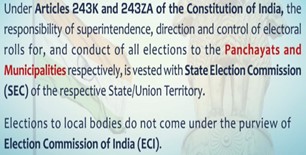
Acts relating to elections
Delimitation
- Delimitation is the process of determining the number of seats and boundaries of territorial constituencies for the Lok Sabha and Legislative assemblies.
- The Delimitation Commission is a high-power body whose orders have the force of law.
- Its orders cannot be questioned in a court of law.
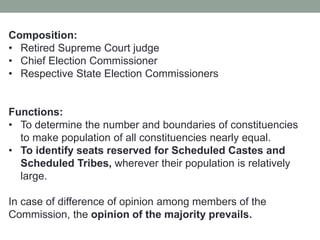
- It involves fixing the seats reserved for Scheduled Castes (SC) and Scheduled Tribes (ST) in these houses.
- As per Article 82 and 170 of the Constitution, the seats in the Lok Sabha and State Legislative assemblies, along with their division into territorial constituencies, are adjusted after each Census.
- The Delimitation Commission, established by an act of Parliament, is responsible for this process.
- Delimitation exercises occurred after the censuses of 1951, 1961, and 1971.
- The Delimitation Commission was formed four times: in 1952, 1963, 1973, and 2002.
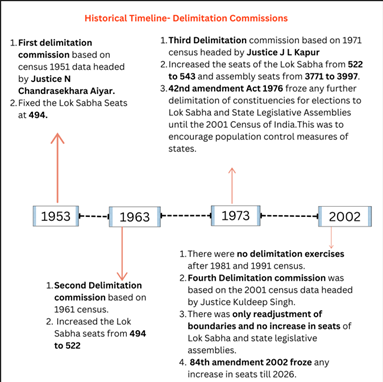
- Delimitation did not occur after the censuses of 1981 and 1991.
- Although delimitation took place after the 2001 census, the number of seats was not increased.
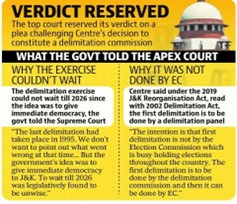
Delimitation Changes in Jammu and Kashmir:
- Delimitation, which balances voter representation, didn't happen in Jammu and Kashmir for over two decades due to a state Assembly law.
- The revocation of special status (Article 370) led to change.
- The Jammu and Kashmir Reorganisation Act, 2019, increased seats from 111 to 107.
- Ladakh becomes a Union Territory.
- It reduced seats to 107, including those in Pakistan-occupied Kashmir.
- Before 2019, parliamentary constituencies had 6 seats and Assembly had 107 seats.
- Post-reorganization, both constituencies fall under the Constitution of India.
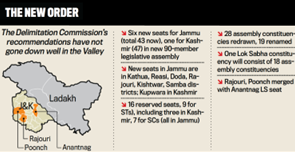
Delimitation Act, 2002
- The Delimitation Act, 2002 was enacted to address the need for readjustment and division of each State into territorial constituencies based on the 2001 census.
- Articles 82 and 170 of the Constitution of India empower Parliament to determine the process of delimitation.
- Articles 330 and 332 of the Constitution allow for re-fixing the number of seats reserved for Scheduled Castes and Scheduled Tribes based on the 2001 census.
- The current delimitation of Parliamentary and Assembly constituencies is based on the 1971 census, leading to uneven population growth and migration-related distortions.
- The Delimitation Act, 2002 established a Delimitation Commission to correct the disparities in constituency sizes based on the 2001 census.
- The Commission was tasked with re-fixing the number of seats for Scheduled Castes and Scheduled Tribes without altering the total number of seats based on the 1971 census.
- This act outlined guidelines for the delimitation process.
- The Delimitation Commission aimed to finish its work by July 31, 2008.
- Delimitation applies to all general elections to the House of the People or State Legislative Assembly held after the publication of the Commission's final orders.
- This includes bye-elections resulting from such general elections.
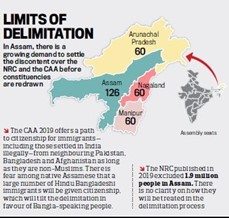
Constitutional requirement
- Democracy, defined as government by the people, necessitates that the government is elected by a majority adhering to the principle of 'one citizen-one vote-one value'.
- Initially, the number of Lok Sabha seats was fixed based on the populations recorded in the 1951, 1961, and 1971 Censuses, resulting in 494, 522, and 543 seats respectively.
- However, to encourage population control, seat allocation has been frozen since the 1971 Census.
- This measure was introduced through the 42nd Amendment Act until 2000 and further extended by the 84th Amendment Act until 2026.
- As a consequence, the allocation of seats currently relies on the population recorded in the 1971 Census.
- Plans are in place to re-adjust this allocation after the first Census post-2026.
- While the boundaries of territorial constituencies were adjusted following the 2001 Census, without altering the number of seats, a similar adjustment is slated to occur after 2026.
- The delimitation process, encompassing seat numbers, constituency boundaries, and reserved seats for SC and ST, would typically be conducted based on the 2031 Census.
- However, discussions about the impending delimitation exercise have emerged due to the postponement of the 2021 Census and the approaching year 2026.
Issues
- The number of seats were frozen based on the 1971 Census in order to encourage population control measures.
- The population explosion that happened in our country during the last five decades has been uneven with some States like Uttar Pradesh, Bihar, Madhya Pradesh and Rajasthan having a greater increase than States like Kerala, Tamil Nadu, Karnataka and Andhra Pradesh.
- There are two options that are being discussed in the public domain with respect to the revised delimitation exercise based on the projected population of various States as of 2026.
- The first is to continue with the existing 543 seats and their redistribution amongst various States (Table 1).
- And the second is to increase the number of seats to 848 with proportionate increase among various States (Table 2).
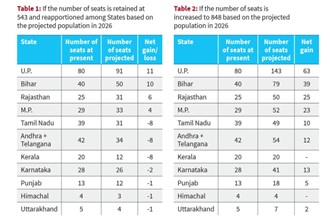
- Southern states, along with smaller northern states like Punjab, Himachal Pradesh, and Uttarakhand, and northeastern states, likely disadvantaged compared to larger northern states like Uttar Pradesh, Bihar, Madhya Pradesh, and Rajasthan.
- Potential violation of federal principles and feelings of disenchantment among populations in states facing reduced representation.
- Contradiction with the philosophy of seat freezing based on the 1971 Census, as states with better population control lose political significance.
International practices
- In the U.S., House of Representatives seats capped at 435 since 1913.
- Population increased from 9.4 crore in 1911 to 33.4 crore in 2023.
- Seats redistributed after each Census via 'equal proportion' method; minimal changes.
- E.g., Census 2020: 37 States unchanged, Texas increased its representation by two seats, while five states saw an additional seat added to their representation. Conversely, seven states experienced a reduction of one seat each.
- In EU Parliament (720 members), seats divided among 27 countries via 'degressive proportionality'.
- Population-to-seat ratio increases with population growth.
- For instance, Denmark (population: 60 lakh) has 15 seats, resulting in an average population per member of approximately 4 lakh people.
- Meanwhile, Germany (population: 8.3 crore) holds 96 seats, averaging around 8.6 lakh people per member.
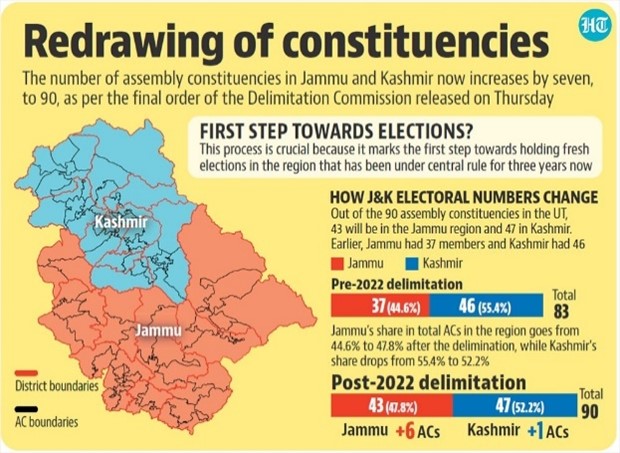
Ideal solution
- The delimitation process faces a challenge due to conflicting democratic and federal principles.
- However, by valuing both principles equally, a harmonious solution can be achieved.
- The main work of a Member of Parliament is to legislate on ‘Union List’ matters like Defence, External Affairs, Railways, Telecommunication, Taxation etc. and hold the Central government accountable.
- Majority of the schemes of the Central government are implemented only by the State governments.
- The Lok Sabha's MP count could remain at 543, preventing disruption in state representation.
- This will maintain and uphold the federal principle.
- The suggestion involves adjusting the number of MLAs in each state to reflect its current population, without altering the number of Rajya Sabha seats.
- This ensures that representation aligns with demographic changes.
- Additionally, it emphasizes the importance of empowering local bodies such as panchayats and municipalities.
- Strengthening their authority and providing adequate financial resources is essential for enhancing grassroots democracy and citizen engagement at the local level.
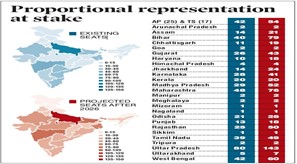
Other acts relating to elections
- The Parliament (Prevention of Disqualification) Act, 1959 allows government officials holding certain profit-making positions to also serve as Members of Parliament without disqualification.
- Scheduled Castes and Scheduled Tribes Orders (Amendment) Act, 1976 provides for the inclusion in, and the exclusion from, the lists of Scheduled Castes and Scheduled Tribes, of certain castes and tribes, for the readjustment of representation of parliamentary and assembly constituencies.
- Government of Union Territories Act, 1963.
- Government of National Capital Territory of Delhi Act, 1991.
- Presidential and Vice-Presidential Elections Act, 1952 regulates certain matters relating to or connected with elections to the offices of the President and Vice-President of India.
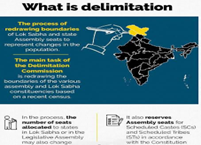
-------------------------------------
Leave a Reply
Your Comment is awaiting moderation.


